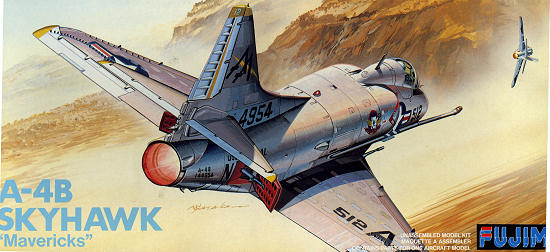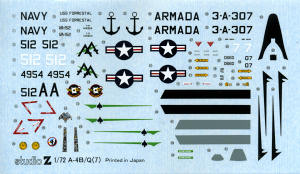
Fumimi 1/72 A-4B Skyhawk
| KIT #: | 26101 |
| PRICE: | 1200 yen when new |
| DECALS: | Two options |
| REVIEWER: | Scott Van Aken |
| NOTES: |

| HISTORY |
The Douglas A-4 Skyhawk is a carrier-capable ground-attack aircraft developed for the United States Navy and United States Marine Corps. The delta winged, single-engined Skyhawk was designed and produced by Douglas Aircraft Company, and later McDonnell Douglas. It was originally designated the A4D under the U.S. Navy's pre-1962 designation system.
The Skyhawk is a light-weight aircraft with a maximum takeoff weight of 24,500 pounds (11,100 kg) and has a top speed of more than 600 miles per hour (970 km/h). The aircraft's five hardpoints support a variety of missiles, bombs and other munitions and was capable of delivering nuclear weapons using a low altitude bombing system and a "loft" delivery technique. Prior to the A-4E, power was supplied by the Wright J65 engine; on the A-4E, the J65 was replaced by the 9,300-pound-force (41 kN) Pratt & Whitney J52.
Skyhawks played key roles in the Vietnam War, the Yom Kippur War, and the Falklands War. Fifty years after the aircraft's first flight, some of the nearly 3,000 produced remain in service with several air arms around the world, including the Brazilian Navy's aircraft carrier,São Paulo.
A4D-2 (A-4B): Strengthened aircraft and added air-to-air refueling capabilities, improved navigation and flight control systems, provision for AGM-12 Bullpup missile, 542 built.
A-4Q: Remanufactured A-4Bs sold to Argentine Navy.
| THE KIT |
 Back in the late 1980s and early 1990s, Fujimi produced a series of aircraft kits that was very well received and are still considered to be some of the best they have done, even today. These kits were highlighted by finely engraved panel lines and excellent parts detail. What is more, they were so designed as to be able to produce a raft of variants of the type. One of those kit lines was with the Skyhawk.
Back in the late 1980s and early 1990s, Fujimi produced a series of aircraft kits that was very well received and are still considered to be some of the best they have done, even today. These kits were highlighted by finely engraved panel lines and excellent parts detail. What is more, they were so designed as to be able to produce a raft of variants of the type. One of those kit lines was with the Skyhawk. Those with the Airfix 1/72 A-4B can rob this item from that kit if you are not going to use it. The other is the ILS antennas on the upper fin. You will also need to make a new UHF antenna behind the cockpit. For both options, the small blast shields for the guns will have to be cut away.
Those with the Airfix 1/72 A-4B can rob this item from that kit if you are not going to use it. The other is the ILS antennas on the upper fin. You will also need to make a new UHF antenna behind the cockpit. For both options, the small blast shields for the guns will have to be cut away. | CONCLUSIONS |
Thankfully, this kit is one of many Fujimi kits that is still available from a number of stockists. Many consider these Fujimi Skyhawks the best available in this scale, despite being nearly 25 years old. This particular kit has a date of 3/1988. If you even have the chance to build one, you will want to get others.
| REFERENCES |
My thanks to www.dragonmodelusa.com for the review kit. Get yours today at your local retailer or ask them to order it in for you.
September 2012
If you would like your product reviewed fairly and fairly quickly, please contact the editor or see other details in the